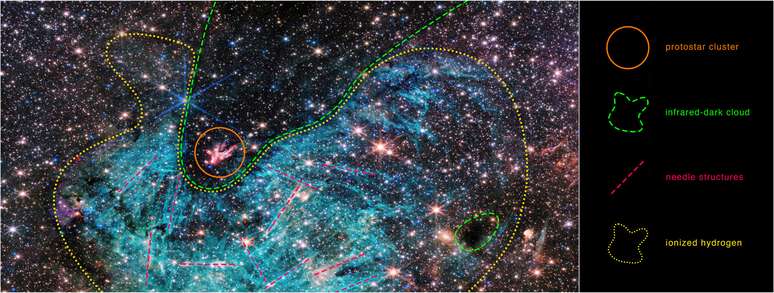The James Webb Space Telescope (JWST) has just released a stunning image of the dense center of the Milky Way. Details of the heart of our galaxy have been revealed through gas and dust, thanks to NIRCam (Near Infrared Camera) technology, producing new images of great scientific value.
Not yet explained by astronomers, also because never seen before, the region hosts an area of space where stars are born, known as Sagittarius C, which lies 300 light-years from the supermassive black hole at the center of the Milky Way, Sagittarius A*. Even affected by radiation from densely populated stars, this intense nursery witnesses the birth of around 500,000 stars.
Explaining how stars are born in an environment so disturbed by the turbulent “last breaths” of dead stars remains a mystery. For the lead researcher of the observation group, Samuel Crowe, of the University of Virginia (UVA) in Charlottesville, USA, “infrared data have never been obtained in this region with the level of resolution and sensitivity that we have obtained with Webb” .
How is the heart of the Milky Way revealed by James Webb?
The immense area shown in this recent JWST image is about 50 light-years from end to end and is about 25,000 light-years from Earth. According to NASA, “the galactic center is close enough to study individual stars with the Webb telescope”.
This includes insider information about how stars form in this specific region compared to others. The process, which could depend on the cosmic environment, would explain, for example, whether the most massive stars form in the center of the Milky Way or at the edges of its spiral arms.
The protostars of the Milky Way
The great discovery in the recent image of the interior of the Milky Way, among the 500 thousand stars, it is a cluster of protostars still in the early stages of star formationthat is, gaining mass and “producing streams that glow like a campfire in the middle of a dark infrared cloud,” according to NASA.
But, amidst this cluster of rising stars, it attracts attention a massive protostar, more than 30 times the mass of our Sun. Other structures that will deserve particular attention from researchers are the needle-like formations pointing chaotically in various directions, within the ionized hydrogen, which loses its characteristic electron due to the high energy conditions of the place.
The cloud from which protostars come is so dense, astronomers say, that the light from the stars behind it cannot reach the JWSTgiving the illusion of little crowding, when, in reality, “it is one of the most densely populated areas in the image”, explains the space agency.
Did you like the content? So, stay updated on James Webb’s other discoveries here on TecMundo and also take this opportunity to read the clues about the formation of the Earth billions of years ago detected by NASA’s super telescope.
Source: Terra
Rose James is a Gossipify movie and series reviewer known for her in-depth analysis and unique perspective on the latest releases. With a background in film studies, she provides engaging and informative reviews, and keeps readers up to date with industry trends and emerging talents.








